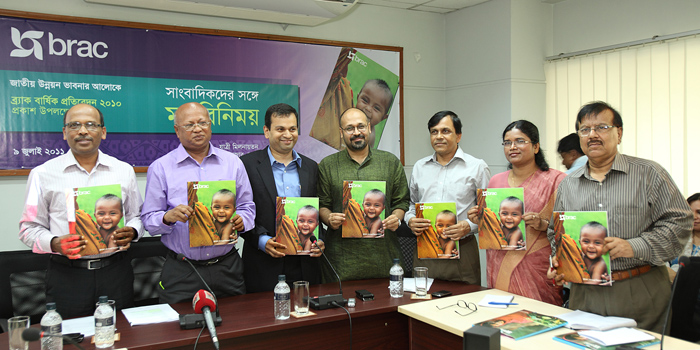
09 July 2011, Dhaka. At an informal opinion exchange programme with the journalists, BRAC's 2010 Annual report was launched today at the Jatri Auditorium. Addressing the need for accountability and transparency, BRAC's Executive Director Dr. Mahabub Hossain presented the report in light of national and millennium development goals. He stressed that BRAC is performing a complimentary role to the government in attaining the millennium development goal for the country and highlighted some of the success stories. Various questions from the journalists were answered by the Executive Director, BRAC International's deputy executive director Dr. Imran Matin, BRAC Group's chief financial officer S.N.Kairy, communications director Asif Saleh, director of education programme Dr. Safiqul Islam, Agriculture programme head Dr. Monoranjan Mondol, Disaster and Environment and Climate Change Director Dr. Babar Kabir, HRLS director Dr. Faustina Perrera, Community Empowerment Director Anna Minj, Associate director Health Dr. Kaosar Afsana, Associate Director Rabeya Yasmin and various other programme leads.
In this report, it was highlighted that there has been considerable progress in Bangladesh in attaining the millennium development goal. In this light, BRAC's performances in addressing the 8 MDGs were discussed. Particularly in the field of health and education and poverty reduction, the results have been very encouraging. BRAC's pre-primary education programme to encourage enrollment had almost 3,29,000 children. In primary education, the rate of primary school enrollment nationally is now almost 100%. BRAC is currently working on reducing the drop outs and reaching the areas which are hard to reach and have fewer government schools. Its non formal primary school in 2010 had almost 610,000 students. Similarly, in health in BRAC areas of operation of 10 districts the rate of maternal mortality has come down to 141 per thousand in urban areas and 157 in rural areas -- remarkably close to attaining the MDG goal of 144. TB detection rate in BRAC covered areas is 78% and recovery rate is 92% which is also well past the MDG target. In the poverty alleviation front, beyond traditional microfinance, BRAC has reached out to almost 80,000 extremely poor household through asset transfer and technical assistant. It has also extended low interest loan to almost 100,000 tenant farmers. BRAC is also working on climate change issues and researching on climate proof crops for the coastal areas.
Through these services of BRAC and BRAC International almost 138 million people throughout the world are within the reach of some kind of BRAC services. Outside Bangladesh BRAC has expanded to 9 other countries in Asia, Africa and the Caribbeans. In Afghanistan and Uganda, BRAC is now the largest NGO. Outside Bangladesh almost 30 million people are within BRAC's reach. In terms of number of people engaged, BRAC is now the biggest development organisation in the world.
Next year BRAC will celebrate its 40th year of operation. Innovation, Effectiveness, Integrity and Inclusiveness -- keeping these four values in mind, BRAC will continue to work in the coming days to bring the most disadvantaged back into the mainstream. In this context, the executive Director highlighted some future plans which included:
- Keeping the MDGs in mind, having a more integrated development approach in selected upazillas
- Taking coordinated initiatives for Dhaka slum dwellers and street children
- Incorporating information technology in development activities to make it more efficient and cost effective
- Having an integrated development approach for the youth of the country in synch with their current needs.
In the programme, the executive director divided BRAC's programmes in three key groups --- poverty alleviation, social security and capacity building and lastly community empowerment. BRAC also has social enterprises which started to address social needs but generates income for BRAC which is used for long term self sustainability of BRAC. Part of these profits is reinvested in the enterprises and the rest goes towards funding the development programmes. Approximately, 30% of BRAC's budget is from foreign grant and the rest of the fund is managed by BRAC.
- BRAC Annual Report 2010 Download [PDF-4 MB] or Read Online
- Annual Report Review (in Bangla)








